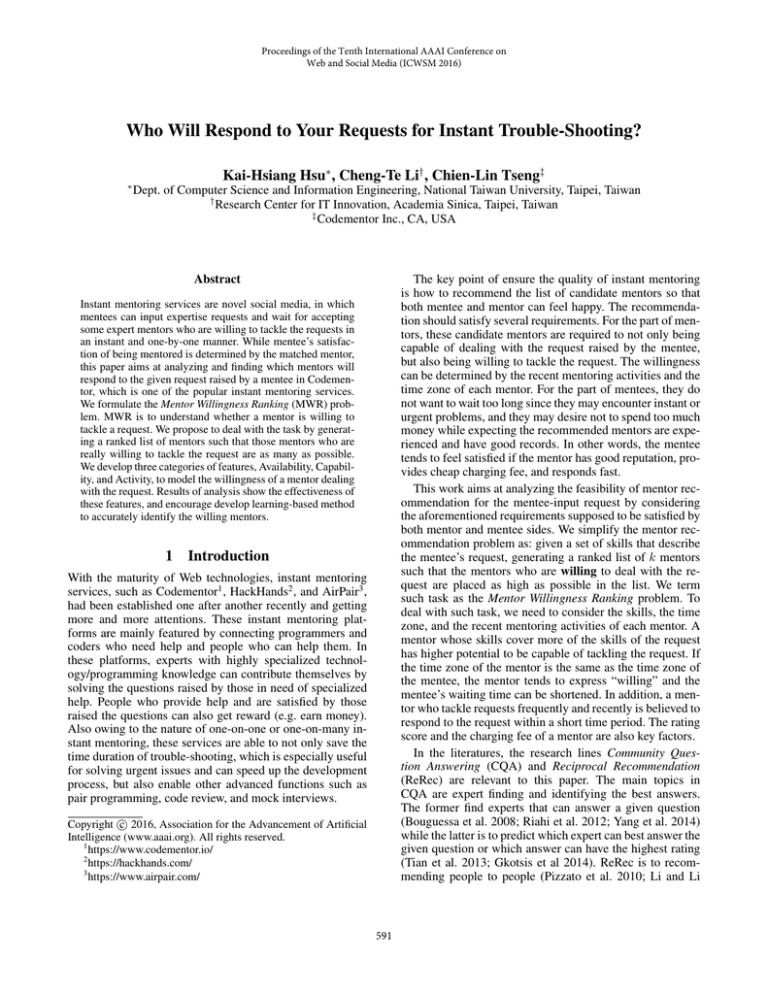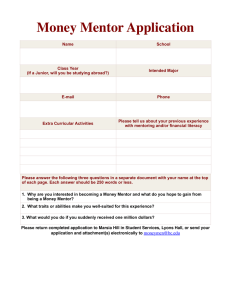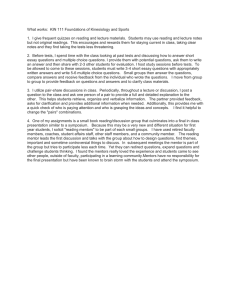
Proceedings of the Tenth International AAAI Conference on
Web and Social Media (ICWSM 2016)
Who Will Respond to Your Requests for Instant Trouble-Shooting?
∗
Kai-Hsiang Hsu∗ , Cheng-Te Li† , Chien-Lin Tseng‡
Dept. of Computer Science and Information Engineering, National Taiwan University, Taipei, Taiwan
†
Research Center for IT Innovation, Academia Sinica, Taipei, Taiwan
‡
Codementor Inc., CA, USA
The key point of ensure the quality of instant mentoring
is how to recommend the list of candidate mentors so that
both mentee and mentor can feel happy. The recommendation should satisfy several requirements. For the part of mentors, these candidate mentors are required to not only being
capable of dealing with the request raised by the mentee,
but also being willing to tackle the request. The willingness
can be determined by the recent mentoring activities and the
time zone of each mentor. For the part of mentees, they do
not want to wait too long since they may encounter instant or
urgent problems, and they may desire not to spend too much
money while expecting the recommended mentors are experienced and have good records. In other words, the mentee
tends to feel satisfied if the mentor has good reputation, provides cheap charging fee, and responds fast.
This work aims at analyzing the feasibility of mentor recommendation for the mentee-input request by considering
the aforementioned requirements supposed to be satisfied by
both mentor and mentee sides. We simplify the mentor recommendation problem as: given a set of skills that describe
the mentee’s request, generating a ranked list of k mentors
such that the mentors who are willing to deal with the request are placed as high as possible in the list. We term
such task as the Mentor Willingness Ranking problem. To
deal with such task, we need to consider the skills, the time
zone, and the recent mentoring activities of each mentor. A
mentor whose skills cover more of the skills of the request
has higher potential to be capable of tackling the request. If
the time zone of the mentor is the same as the time zone of
the mentee, the mentor tends to express “willing” and the
mentee’s waiting time can be shortened. In addition, a mentor who tackle requests frequently and recently is believed to
respond to the request within a short time period. The rating
score and the charging fee of a mentor are also key factors.
In the literatures, the research lines Community Question Answering (CQA) and Reciprocal Recommendation
(ReRec) are relevant to this paper. The main topics in
CQA are expert finding and identifying the best answers.
The former find experts that can answer a given question
(Bouguessa et al. 2008; Riahi et al. 2012; Yang et al. 2014)
while the latter is to predict which expert can best answer the
given question or which answer can have the highest rating
(Tian et al. 2013; Gkotsis et al 2014). ReRec is to recommending people to people (Pizzato et al. 2010; Li and Li
Abstract
Instant mentoring services are novel social media, in which
mentees can input expertise requests and wait for accepting
some expert mentors who are willing to tackle the requests in
an instant and one-by-one manner. While mentee’s satisfaction of being mentored is determined by the matched mentor,
this paper aims at analyzing and finding which mentors will
respond to the given request raised by a mentee in Codementor, which is one of the popular instant mentoring services.
We formulate the Mentor Willingness Ranking (MWR) problem. MWR is to understand whether a mentor is willing to
tackle a request. We propose to deal with the task by generating a ranked list of mentors such that those mentors who are
really willing to tackle the request are as many as possible.
We develop three categories of features, Availability, Capability, and Activity, to model the willingness of a mentor dealing
with the request. Results of analysis show the effectiveness of
these features, and encourage develop learning-based method
to accurately identify the willing mentors.
1
Introduction
With the maturity of Web technologies, instant mentoring
services, such as Codementor1 , HackHands2 , and AirPair3 ,
had been established one after another recently and getting
more and more attentions. These instant mentoring platforms are mainly featured by connecting programmers and
coders who need help and people who can help them. In
these platforms, experts with highly specialized technology/programming knowledge can contribute themselves by
solving the questions raised by those in need of specialized
help. People who provide help and are satisfied by those
raised the questions can also get reward (e.g. earn money).
Also owing to the nature of one-on-one or one-on-many instant mentoring, these services are able to not only save the
time duration of trouble-shooting, which is especially useful
for solving urgent issues and can speed up the development
process, but also enable other advanced functions such as
pair programming, code review, and mock interviews.
c 2016, Association for the Advancement of Artificial
Copyright Intelligence (www.aaai.org). All rights reserved.
1
https://www.codementor.io/
2
https://hackhands.com/
3
https://www.airpair.com/
591
that the number of recommended mentors (in the list) who
are willing to tackle the request is as many as possible. That
said, MWR is to find whether a mentor is willing to provide
help for the request.
Since what we have is the historical willingness records
for each mentor, we aim at using these records to develop
features that can effectively characterize the willingness of
each mentor for a request. When a new request is input, we
can use the feature score to generate the ranked list of mentors such that the recommended mentors are truly willing
to deal with the request. In the following, we will devise a
series of features to characterize the possibility of a mentor
who is willing to tackle the request. Then we conduct some
empirical studies to show the effectiveness of each feature.
Table 1: Data statistics of the used Codementor data.
#requests = 11,196
#willingness = 39,641
#mentors = 3,428
#matches = 4,165
#willingness per mentor = 19.65
#willingness per request = 3.54
#mentees = 70,712
#tags = 9,549
#tags per mentor = 17.66
#tags per request = 3.17
2012; Kutty et al. 2014), in which the preferences of both
of the participated parties (e.g. male-female matching) are
supposed to be satisfied. However, both CQA and ReRec
consider neither the willingness of the experts (or people in
one party) to respond to the requests to approve the recommendation, which is what we tackle in this paper.
The instant mentoring service we target at is Codementor.
We will present the data statistics for Codementor’s requests,
mentors, mentees, and matched mentor-mentee pairs. Since
MWR is to analyze the willingness of mentors by generating a ranked list of mentors for the given request, we propose
to characterize mentors’ willingness to tackle requests. We
develop three categories of features, including Availability,
Capability, Activity, and Proximity to model the willingness
of a mentor dealing with the request. These features are extracted based on the request, the profile of a mentor, and the
historical activities of a mentor. In the analysis, we will use
each proposed feature score of generate the ranking of mentors. In addition, we also exhibit whether each feature is able
to distinguish “willing” and “unwilling” mentors.
2
3.2
We propose three categories of predictive features to recommend mentors: availability, capability, and activity. The general idea is to estimate the willingness that a mentor wants to
tackle the request. All of these features are extracted based
on the request (including the time of request, the required
skills, and the budget), the profile of each mentor (including skills, time zone, rating, and charging fee), and the historical activities of each mentor (including delivered “willing” to which of past requests at what time, and successfully
matched with which of past requests at what time).
Availability features aims at quantifying the availability of mentors in terms of time, and the availability of the
mentee in terms of budget. Higher availability indicates
higher tendency that a successful match happens between
a mentor and the mentee.
Codementor Data and Analysis
We use a collection of data from one of the largest instant mentoring services, Codementor, during the time period from April 19, 2015 to November 15, 2015. Before describing the insights of the data, we need to point out the current Codementor’s mechanism for recommending mentors
so that the input requests can be forwarded to them. Codementor hires an programming expert to manually generate a
ranked list of 100 mentors who are most likely being willing to deal with the request and being better satisfied by the
mentee. The manual generation process is based on the tags,
time zones, rating, charging fee, and historical willingness
and mentoring records of mentors. Therefore, we have the
list of manually-recommended mentors for each request. By
running with such lists, mentors’ willingness (to requests)
records can be collected. We use these records for this study.
The data statistics of our used data is shown in Table 1, in
which #willingness refers to the number of expressing “willing” by mentors to requests, and #matches means the number of successful matched mentor-mentee pairs.
3
3.1
Predictive Features
• Time Zone Closeness. Due to the daily routine and biological clock of human beings, if the time zone of the mentor
is far away from the time zone of the mentee, the willingness of the mentor to tackle the request is supposed to be
lower. We propose to measure the closeness between time
zones of a mentor m and the request q as
min(ΔT (m, q), 24 − ΔT (m, q))
,
12
(1)
where ΔT (m, q) = m.ltz − q.ltz, and m.ltz is the local
time zone of m. Higher T ZClose(m, q) values indicates
higher availability and the mentor m has higher possibility to tackle the request q.
T ZClose(m, q) = 1−
• Online Availability. A direct manner to find the availability of mentor q is whether he/she is online at the time
that the request q gets posted. As Codementor allows each
mentor to indicate whether he/she is online now, we devise a binary feature considering both time zone and online status to understand the availability of a mentor.
Mentor Willingness Ranking in
Codementor
Problem Formulation
OA(m, q) =
We first provide the formulation of the Mentor Willingness
Ranking (MWR) problem. Given a request q that is input
by a certain mentee, a set of skills Lq for request q, and a
collection of mentors, in which each mentor m contains a
set of skills Lm , and the number of k mentors to be recommended, the goal is to return a ranked list of k mentors such
1,
0,
if m.status = “online” and m.ltz = q.ltz
otherwise
(2)
• Budget. We also need to measure the availability in terms
of budget of the mentee who proposes the request. If the
charging fee of mentor m is close to the budget of request
592
q, then m tends to be available to q. We use the difference between m’s charging fee and q’s budget to define
the feature.
1,
if ΔB (m, q) ≤ 1
, (3)
BA(m, q) = √ 1
, otherwise
of mentoring sessionsas is treated as the feature, given by
SessionLen(m) = b∈Bm T D(b), where Bm is the set
of sessions of mentor m, and T D(b) is the time duration
of session b.
Activity features are to capture the mentoring activities of
a mentor. A mentor who either frequently express “willing”
to tackle requests or frequently being accepted by mentees
is considered as an enthusiastic one, and has higher potential to provide instant trouble-shooting. We quantify the
mentoring activities from two temporal aspects: instant time
and recent time. Instant-time activities of mentor m refer
to the historical interactions between m and mentees within
one certain time difference (e.g. one hour) before and after a request gets posted, while recent-time ones represent
the recent interactions between m and mentees in the past
week. Assume a request q is posted at timestamp Tq (e.g.
201512241002) whose time of day is denoted by tq (e.g.
(m, q) be respectively the
1002), let Nins (m, q) and Nins
times of expressing “willing” and the times of establishing
mentoring sessions by mentor m to any historical requests
within time period tq − ΔA ≤ t ≤ tq + ΔA , where ΔA is
the instant time difference and empirically set as 60 minutes
(m, q) be
in this study. In addition, let Nrec (m, q) and Nrec
respectively the times of expressing “willing” and the times
of establishing mentoring sessions by mentor m to any historical requests within time period Tq − ΔR ≤ T ≤ Tq ,
where ΔR is the recent time difference and empirically set
as 168 hours in this study. We define the following four activity features.
• Instant Willingness. A mentor m delivering more instanttime “willing” around tq has higher possibility to tackle
request q within a short time period. We define the instant,
willingness feature as: W I(m, q) = Nins (m,q)
u∈M \m Nins (u,q)
where M is the set of all the mentors in the data.
• Instant Sessions. A mentor m accepted by more mentees
around Tq tends to be accepted to deal with new request
q within a short time period. The feature is defined as:
N (m,q)
SI(m, q) = ins N (u,q)
ΔB (m,q)
where ΔB (m, q) = m.chargingF ee − q.budget.
Capability features are proposed to quantify whether or
not the mentor q is qualified to deal with the request q considering m’s expertise, rating by past mentees, and past mentoring sessions. It is believed that the capability is the most
important factor affecting the mentee to select which of the
recommended mentors.
• Skill Matching. The most intuitive way to estimate the capability of a mentor is to examine the degree of matching
between the skills of the mentor and the required skills
of the request. We consider two factors for skill matching. The first is skill coverage. If the skill set of a mentor
covers more required skills of the request, such mentor is
more eligible. The second is skill uniqueness. Some skills
are common while some are unique. A mentor possesses
an unique required skill can better deal with the request
and satisfy the need of the mentee, compared with a common required skill. Let the skill set of mentor m as Lm ,
and the required skill set of the request q as Lq . We define
the feature of skill matching as:
l∈L ∩L Rarity(l)
SkillM atch(m, q) = m q
,
(4)
l∈Lq Rarity(l)
where Rarity(l) is the rarity of skill l, defined by
, and f req(l) is the number of
Rarity(l) = √ 1
f req(l)+1
mentors who possess skill l.
• Rating. The quality of the mentor can be directly reflected by his/her rating score, which is rated by mentess
based on past mentoring sessions. We use the technique
of Bayesian Average on the rating records of mentor m.
Let a certain rating record score i of mentor m as rm (i),
and let the total number of rating records of m as cm . We
define the Bayesian Average Rating (BAR) of m as:
cm
rm (i)
C × r̄ + i=1
,
(5)
BAR(m) =
C + cm
u∈M \m
ins
• Recent Willingness. If mentor m very actively expresses
“willing” to requests in recent days before Tq , he/she has
higher potential to tackle request q. We define the recent(m,q)
, where
willingness feature as: W R(m, q) = Nrec
|QT |
QT is the set of all the requests posted within Tq − ΔR ≤
T ≤ Tq .
• Recent Sessions. Likewise, if mentor m is very frequently
accepted by mentees in recent days before Tq , he/she can
be very popular recently and can be accepted by mentees
to deal with new request q. The feature is defined as:
N (m,q)
.
SR(m, q) = rec
|QT |
where C is the total number of rating records among all
the mentors, and r̄ is the average values of rating scores
among all the mentors.
• Session Length. When a mentee selects a recommended
mentors, an instant mentoring session will be created. We
consider the mentoring session to approximate the capability of a mentor. If a mentor either frequently establishes
sessions with mentees, such mentor can be regarded as an
experienced one. Also if the time duration of a mentoring
session is longer, the mentor in such session can deliver
more knowledge to the mentee, and the mentor is more
trustful because the mentee is willing to pay more to have
longer discussion with the mentor. The total time duration
4
Results of Analysis
To verify the effectiveness of the proposed predictive features in differentiating mentors with and without willingness, we plot the cumulative distribution functions (CDF)
of various features, as shown in Figure 1. The plot reflects
593
Figure 2: Comparison of the average acceptance ranks (using individual feature values to generate a ranked list of
mentors) for availability, capability, and activity features.
This study is first attempt to explore mentors’ response willingness in instant mentoring services, and the results encourage advanced analysis and developing complicated models
to generate more satisfying mentors to mentees.
6
Figure 1: Comparison of the cumulative distribution functions of various features (values) for mentors with willingness, mentors without willingness, and irrelevant mentors.
the effectiveness of a feature, and consists of three curves
corresponding to mentors with and without willingness, and
irrelevant mentors who are randomly selected from the collection of all mentors. The bigger the area between curves of
mentors with and without willingness, the more effective the
feature is in differentiating the willingness or not. We can see
that the proposed features are generally able to distinguish
mentors with willingness from those without willingness. It
is especially effective for availability and proximity features.
Note that due to page limit, we do not present the results for
all of the features, but they exhibit similar trends.
We also verify whether the proposed features are effective in ranking the final accepted mentors (by mentees) at
high positions of the recommended list of mentors. We generate the box plots of acceptance rank of the ground-truth
accepted mentor using each feature, as shown in Figure 2.
The higher the rank (the lower rank value) is, the more effective the feature is in finding the mentors really accepted
by mentees. We can find activity features can produce better
rankings, and capability features work well, too. These observations from feature analysis encourages us to combine
these features using supervised learning in the following.
5
Acknowledgements
This work was sponsored by Ministry of Science and Technology (MOST) of Taiwan under grant 104-2221-E-001027-MY2. This work is also supported by Multidisciplinary
Health Cloud Research Program: Technology Development
and Application of Big Health Data, Academia Sinica,
Taipei, Taiwan under grant MP10212-0318.
7
References
Bouguessa, M.; Dumoulin, B.; and Wang, S. 2008. Identifying authoritative actors in question-answering forums: the
case of yahoo! answers. In Proc. of KDD, 866-874.
Gkotsis, G.; Stepanyan, K.; Pedrinaci, C.; Domingue, J.;
and Liakata, M. 2014. It’s all in the content: state of the art
best answer prediction based on discretisation of shallow
linguistic features. In Proc. of ACM WebSci, 202-210.
Kutty, S.; Nayak, R.; and Chen, L. 2014. A People-toPeople Matching System Using Graph Mining Techniques.
World Wide Web Journal, 17:311-349.
Li, L; and Li, T. 2012. MEET: A Generalized Framework
for Reciprocal Recommendation Systems. In Proc. of ACM
CIKM, 35-44.
Pizzato, L.; Rej, T.; Chung, T.; Koprinska I.; and Kay, J.
2010. RECON: A Reciprocal Recommender for Online
Dating. In Proc. of ACM Recommender Systems, 207-214.
Riahi, F.; Zolaktaf, Z.; Shafiei, S.; and Milios, E. 2012.
Finding Expert Users in Community Question Answering.
In WWW 2012 Companion (CQA workshop), 791-798.
Tian, Q.; Zhang, P.; and Li, B. 2013. Towards Predicting the
Best Answers in Community-Based Question-Answering
Services. In Proc. of ICWSM, 725-728.
Yang, B.; and Manandhar. S. 2014. Tag-based expert
recommendation in community question answering. In
Proc. of IEEE/ACM ASONAM, 960-963.
Conclusion
This paper proposes to analyze which mentors would like
to respond the request input by a mentee in an instant mentoring service, Codementor. We formulate the Mentor Willingness Ranking problem. Based on the given requests, we
devise three diverse sets of features to model the mentors’
willingness, including Availability, Capability, and Activity.
These feature sets are validated to be effective for both tasks.
594




